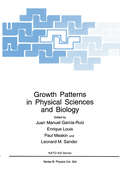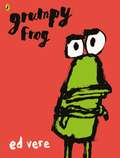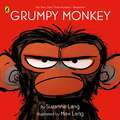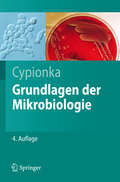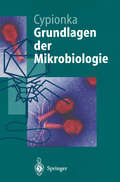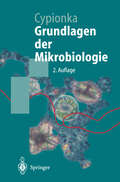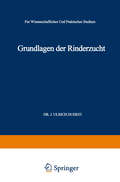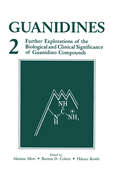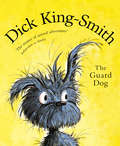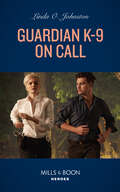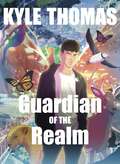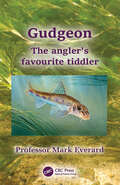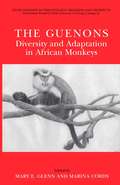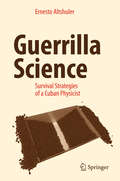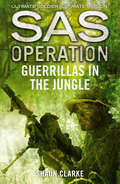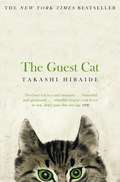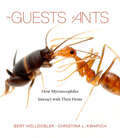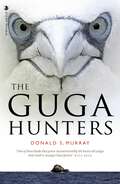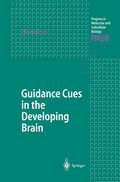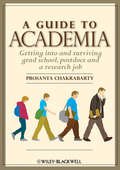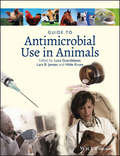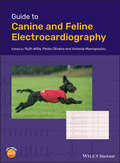- Table View
- List View
Growth Patterns in Physical Sciences and Biology (Nato Science Series B: #304)
by Juan Manuel Garcia-Ruiz Enrique Louis P. Meakin Leonard M. SanderDuring the past decade interest in the formation of complex disorderly patterns far from equilibrium has grown rapidly. This interest has been stim ulated by the development of new approaches (based primarily on fractal geometry) to the quantitative description of complex structures, increased understanding of non-linear phenomena and the introduction of a variety of models (such as the diffusion-limited aggregation model) that provide paradigms for non-equilibrium growth phenomena. Advances in computer technology have played a crucial role in both the experimental and theoret ical aspects of this enterprise. Substantial progress has been made towards the development of comprehensive understanding of non-equilibrium growth phenomena but most of our current understanding is based on simple com puter models. Pattern formation processes are important in almost all areas of science and technology, and, clearly, pattern growth pervades biology. Very often remarkably similar patterns are found in quite diverse systems. In some case (dielectric breakdown, electrodeposition, fluid-fluid displacement in porous media, dissolution patterns and random dendritic growth for example) the underlying causes of this similarity is quite well understood. In other cases (vascular trees, nerve cells and river networks for example) we do not yet know if a fundamental relationship exists between the mechanisms leading the formation of these structures.
Grumpy Frog
by Ed VereGrumpy Frog is not grumpy. He loves green, and he loves to hop, and he loves winning. But what happens when Grumpy Frog doesn't win, or encounters - horror of horrors - a Pink Rabbit?Join Grumpy Frog as he learns about compromise and tolerance, friendship and the power of saying sorry. A hilarious book with a twist in the tail about getting - and getting rid of - the grumps from New York Times best-selling author, Ed Vere.
Grumpy Monkey
by Suzanne LangA hilarious and reassuring New York Times Number 1 bestseller about feeling your emotions - sometimes it's okay not to feel okay!Meet Jim Panzee.He's in a BAD mood.Nothing feels right!Nothing will do, and Jim just doesn't know why...His friends can't understand it - HOW can he be in a mood when it's such a beautiful day!? They have lots of suggestions for how to make him feel better. But Jim can't take all the advice... and has a bit of a meltdown.Could it be that he just needs a day to feel grumpy?This modern classic is the perfect reminder that 'grumpy monkey' days never last long.
Grundlagen der Mikrobiologie (Springer-Lehrbuch)
by Heribert CypionkaWeshalb ist ein Frosch grün? Wie viel Energie benötigt ein Bakterium, um sich zu verdoppeln? Von den Grundlagen des Stoffwechsels über die Vielfalt der Mikroorganismen bis hin zu den Prozessen, die sich im Meer oder bei einer Infektionskrankheit abspielen, erläutert der Autor anhand von Beispielen die grundlegenden Zusammenhänge der Mikrobiologie. Kompakt und doch anspruchsvoll, bietet das Buch einen idealen Einstieg in das Fachgebiet. Die 4. Auflage wurde gründlich überarbeitet und erstmals mit vielen farbigen Bildern ausgestattet.
Grundlagen der Mikrobiologie (Springer-Lehrbuch)
by Heribert CypionkaPrüfungsvorbereitung leicht gemacht: Dieses Kompendium der Mikrobiologie bietet eine umfassende Übersicht über alle Wissensbereiche des Fachgebiets, verständlich aufbereitet mit griffigen Beispielen und zahlreichen Abbildungen. Die Kapitel sind lernfreundlich in zweifarbigem Layout gestaltet mit prüfungsrelevanten Fragen zu Beginn und einer Zusammenstellung wichtiger Fachbegriffe am Ende.
Grundlagen der Mikrobiologie (Springer-Lehrbuch)
by Heribert CypionkaIdealer Einstieg in die Mikrobiologie und zur Vorbereitung auf das Vordiplom! In kompakter Form wird das Basiswissen präzise und verständlich präsentiert. Ausgewählte Beispiele aus Medizin und Alltag veranschaulichen die grundlegenden Zusammenhänge. Eine Besonderheit sind die Fragen zu Beginn und ein Glossar der wichtigsten Fachbegriffe am Ende eines jeden Kapitels, die bei der Prüfungsvorbereitung helfen. Das lernfreundliche Konzept wird durch zahlreiche einprägsame Abbildungen und eine durchgehend zweifarbige Gestaltung unterstützt. Neu hinzugekommen sind etwa 20 Fotos. Die 2. Auflage berücksichtigt Verbesserungsvorschläge der Leser und wurde leicht erweitert.
Grundlagen der Mikrobiologie (Springer-Lehrbuch)
by Heribert CypionkaDie Vielfalt des Lebens der Mikroorganismen auf rund 300 Seiten kompakt und präzise vermittelt - in dritter Auflage, überarbeitet und durch zahlreiche neue Bilder ergänzt. Bei Studenten ist der „Cypionka“ fest etabliert und im Grundkurs zum bevorzugten Einstieg in die Mikrobiologie geworden.
Grundlagen der Rinderzucht: Eine Darstellung der Wichtigsten für die Entwicklung der Leistungen und der Körperformen des Rindes Ursächlichen, Physiologisch-Anatomischen, Zoologisch-Paläontologischen, Entwicklungsmechanischen und Kultur-Historischen Tatsachen und Lehren. Für Wissenschaftliches und Praktisches Studium
by Johann Ulrich DuerstDieser Buchtitel ist Teil des Digitalisierungsprojekts Springer Book Archives mit Publikationen, die seit den Anfängen des Verlags von 1842 erschienen sind. Der Verlag stellt mit diesem Archiv Quellen für die historische wie auch die disziplingeschichtliche Forschung zur Verfügung, die jeweils im historischen Kontext betrachtet werden müssen. Dieser Titel erschien in der Zeit vor 1945 und wird daher in seiner zeittypischen politisch-ideologischen Ausrichtung vom Verlag nicht beworben.
Guanidines 2: Further Explorations of the Biological and Clinical Significance of Guanidino Compounds
by Akitane MoriGuanidine is named for its similarity to the purine guanine which, in turn, is named for its principal source guano, which comes from the Inca word, huano, for dung. Guanidine, therefore, translates into dung-like, which is hardly a genteel way to introduce a subject. On the other hand, texts are seldom inspirational, "frequently crude and rarely literary and should be judged on how successfully they assemble, organize and present current data. I am impressed that the material which fol]ows goes a long way toward successfully achieving those goals. Tue International Guanidine Society is a synthesis of three groups of investigators: biologists studying guanidines as phosphagens, neurologists interested in guanidines as convulsants and nephrologists involved with guanidines as toxins. As a member of the latter group. I am gratified by the considerable progress this book represents. To begin with. there now appears to be a common theme which unifies current speculation concerning the metabolic origin of the guanidines in uremia. At the First International Congress in 1983, evidence was presented which supported the theory that certain guanidines were products of the mixed function oxidation of urea. This year's meeting brings together overwhelming data showing that methyl guanidine is an effect of active oxygen reacting with creatinine. An idolatry, worshipped throughout biochemistry, that urea and creatinine are inert byproducts of protein metabolism, is shown to have feet of clay.
The Guard Dog (PDF)
by Dick King-SmithThere are six puppies in the pet shop window; five posh pedigree puppies, and a scruffy little mongrel with a grand ambition - to be a guard dog. The other pups laugh at him. How can such a small, scruffy dog possibly expect to be bought to guard a home? Especially when his bark is the most horrible, earsplitting racket they have ever heard! Will the poor little guard dog be doomed to a lonely life in the Dogs' Home - or worse...?
Guardian K-9 On Call (Shelter of Secrets #2)
by Linda O. JohnstonProtecting those in need with her K-9 by her side!
Guardian of the Realm: The extraordinary and otherworldly adventure from TikTok sensation Kyle Thomas
by Kyle Thomas John Reppion Leah MooreOUT NOW. Join TikTok sensation Kyle Thomas and his much-loved meerkat Mylo as they embark on their most epic adventure yet - to an alternate dimension filled with beautiful creatures some good . . . and some that will threaten our entire existence. Kyle Thomas and his beloved meerkat Mylo have always been inseparable. But now they're about to be worlds away from life as they know it . . . Stumbling upon an extraordinary and magical alternate world, they enter a land filled with strange and wonderful wild creatures. Everything seems perfect here, but danger is lurking.A dark creature has found its way through an open portal and is wreaking havoc in the real world.People are frightened for their lives. And now it is down to Kyle and Mylo to save the world. _____Kyle and his incredible team: the No. 1 Sunday Times Bestselling Comic Book Artist, Amrit Birdi and scriptwriting powerhouse Leah Moore and John Reppion, who have written for the likes of 2000 AD, Channel 4, Dark Horse and DC Comics, have come together to create Kyle's first ever graphic novel that will transport you to an incredible animal dimension like no other . . .
Gudgeon: The angler's favourite tiddler
by Mark EverardThis book is a celebration of the humble gudgeon, the angler's favourite 'tiddler'. This much-loved little fish is long overdue a little book all of its own. Scientist, author and broadcaster Dr Mark Everard tells tales about the biology of the gudgeon, gudgeon fishing, and the diverse social quirks and values of this most popular of little fishes.
Gudgeon: The angler's favourite tiddler
by Mark EverardThis book is a celebration of the humble gudgeon, the angler's favourite 'tiddler'. This much-loved little fish is long overdue a little book all of its own. Scientist, author and broadcaster Dr Mark Everard tells tales about the biology of the gudgeon, gudgeon fishing, and the diverse social quirks and values of this most popular of little fishes.
The Guenons: Diversity and Adaptation in African Monkeys (Developments in Primatology: Progress and Prospects)
by Mary E. Glenn Marina CordsIt has been twelve years since a work relating to the long-tailed African monkeys known as the guenons has been published and fifteen years have passed since the last major scientific symposium was held that was solely dedicated to current research on members of this monkey group living in the wild. Since that time, new guenon species and subspecies have been discovered, previously unstudied guenon species have become the subject of long-term research projects, and knowledge of the more well-known guenon species has greatly increased. This volume presents novel information and keen insight on research previously studied and newly discovered. A wide range of topics related to guenon biology is presented, including evolution, taxonomy, biogeography, reproductive physiology, social and positional behavior, ecology, and conservation. Composed of 26 chapters compiled by 47 authors, many of whom are young investigators in their field, The Guenons: Diversity and Adaptation in African Monkeys provides a valuable resource for researchers and scientists in the fields of anthropology, primatology, zoology, and conservation biology.
Guerrilla Science: Survival Strategies of a Cuban Physicist
by Ernesto AltshulerFull of drama, dedication, and humor, this book narrates the author’s often frustrating experiences working as an experimental physicist in Cuba after the disintegration of the so-called socialist block. Lacking finance and infrastructure, faced with makeshift equipment, unpredictable supplies, and unreliable IT, Altshuler tells how he and his students overcame numerous challenges to make novel and interesting contributions to several fields of science. Along the way, he explains the science - from studies of ant colonies to superconductivity - either qualitatively or quantitatively, but always at a level fully understandable to an undergraduate student of natural sciences or engineering. An even wider audience, however, may skip the technical sections without missing the essence. With numerous anecdotes, photographs and the author’s own delightful cartoons, the book tells a remarkable, and often amusing story of how successful science can be performed against all odds.
Guerrillas in the Jungle (SAS Operation)
by Shaun ClarkeUltimate soldier. Ultimate mission. But will the SAS patrol escape the deadly Malayan jungle alive?
The Guest Cat
by Takashi HiraideThe Sunday Times and New York Times BestsellerA couple in their thirties live in a small rented cottage in a quiet part of Tokyo. They work at home as freelance writers. They no longer have very much to say to one another. One day a cat invites itself into their small kitchen. She is a beautiful creature. She leaves, but the next day comes again, and then again and again. New, small joys accompany the cat; the days have more light and colour. Life suddenly seems to have more promise for the husband and wife; they go walking together, talk and share stories of the cat and its little ways, play in the nearby Garden. But then something happens that will change everything again.The Guest Cat is an exceptionally moving and beautiful novel about the nature of life and the way it feels to live it. Written by Japanese poet and novelist Takashi Hiraide, the book won Japan's Kiyama Shohei Literary Award, and was a bestseller in France and America.
The Guests of Ants: How Myrmecophiles Interact with Their Hosts
by Bert Hölldobler Christina L. KwapichA fascinating examination of socially parasitic invaders, from butterflies to bacteria, that survive and thrive by exploiting the communication systems of ant colonies. Down below, on sidewalks, in fallen leaves, and across the forest floor, a covert invasion is taking place. Ant colonies, revered and studied for their complex collective behaviors, are being infiltrated by tiny organisms called myrmecophiles. Using incredibly sophisticated tactics, various species of butterflies, beetles, crickets, spiders, fungi, and bacteria insert themselves into ant colonies and decode the colonies’ communication system. Once able to “speak the language,” these outsiders can masquerade as ants. Suddenly colony members can no longer distinguish friend from foe. Pulitzer Prize–winning author and biologist Bert Hölldobler and behavioral ecologist Christina L. Kwapich explore this remarkable phenomenon, showing how myrmecophiles manage their feat of code-breaking and go on to exploit colony resources. Some myrmecophiles slip themselves into their hosts’ food sharing system, stealing liquid nutrition normally exchanged between ant nestmates. Other intruders use specialized organs and glandular secretions to entice ants or calm their aggression. Guiding readers through key experiments and observations, Hölldobler and Kwapich reveal a universe of behavioral mechanisms by which myrmecophiles turn ants into unwilling servants. As The Guests of Ants makes clear, symbiosis in ant societies can sometimes be mutualistic, but, in most cases, these foreign intruders exhibit amazingly diverse modes of parasitism. Like other unwelcome guests, many of these myrmecophiles both disrupt and depend on their host, making for an uneasy coexistence that nonetheless plays an important role in the balance of nature.
The Guga Hunters
by Donald S. Murray‘Deeply moving’ - Will Self, Daily Telegraph‘He writes with an inherent understanding of Highland culture, language and way of life’ - Herald ‘Mesmerising. When I closed this book I was left with the feeling that Donald S. Murray had been paring away layers of centuries of life in Ness for my benefit ... Beautifully judged’ - Jim Crumley, Scots Magazine Every year, ten men from Ness, at the northern tip of the Isle of Lewis, sail north-east for some forty miles to a remote rock called Sulasgeir. Their mission is to catch and harvest the guga; the almost fully grown gannet chicks nesting on the two hundred foot high cliffs that circle the tiny island, which is barely half a mile long. After spending a fortnight in the arduous conditions that often prevail there, they return home with around two thousand of the birds, pickled and salted and ready for the tables of Nessmen and women both at home and abroad.The Guga Hunters tells the story of the men who voyage to Sulasgeir each year and the district they hail from, bringing out the full colour of their lives, the humour and drama of their exploits. They speak of the laughter that seasons their time together on Sulasgeir, of the risks and dangers they have faced. It also provides a fascinating insight into the social history of Ness, the culture and way-of-life that lies behind the world of the Guga Hunters, the timeless nature of the hunt, and reveals the hunt’s connections to the traditions of other North Atlantic countries.Told in his district’s poetry and prose, English and - occasionally - Gaelic, Donald S. Murray shows how the spirit of a community is preserved in this most unique of exploits.
Guidance Cues in the Developing Brain (Progress in Molecular and Subcellular Biology #32)
by IvicaKostovićMany complex molecular interactions are involved in the development of the mammalian brain. Molecules serving as guidance cues for migratory cells, growing axons and for recognition of postsynaptic targets are a major topic for research because they are directly involved in the formation of neuronal circuits, thus creating the foundation for subsequent functional refinement through interactions with the environment. In addition, most guidance cue molecules are also involved in plasticity, damage repair and regeneration in the adult brain. This volume reviews current knowledge on major classes of molecules involved in: guidance of growing axons; tau proteins involved in the establishment of axonal polarity, outgrowth and contact recognition; gangliosides and lectins involved in neuronal migration, neurite outgrowth and contact recognition; and myelin molecules that inhibit nerve regeneration.
A Guide to Academia: Getting into and Surviving Grad School, Postdocs, and a Research Job
by Prosanta ChakrabartyA Guide to Academia is a handbook for all those individuals thinking seriously about going to graduate school. Written by an author with extensive experience navigating the academic world, the book explains all the steps and potential bumps in the road that a student might encounter as they take the plunge into academia. Each chapter begins with a section called the "hard truth," which will help students determine if they are on the right path. Starting with an undergraduate student looking for a graduate school, the reader is taken on a journey up the academic ladder through graduate studies, a postdoctoral fellowship and an assistant professorship. Each chapter gives advice on not only how to survive the current stage but how to get to the next stage quickly. Enhanced with material from the author's own job applications and interview presentations, A Guide to Academia provides concrete examples of the tools needed for a successful career in academia.
A Guide to Academia: Getting into and Surviving Grad School, Postdocs, and a Research Job
by Prosanta ChakrabartyA Guide to Academia is a handbook for all those individuals thinking seriously about going to graduate school. Written by an author with extensive experience navigating the academic world, the book explains all the steps and potential bumps in the road that a student might encounter as they take the plunge into academia. Each chapter begins with a section called the "hard truth," which will help students determine if they are on the right path. Starting with an undergraduate student looking for a graduate school, the reader is taken on a journey up the academic ladder through graduate studies, a postdoctoral fellowship and an assistant professorship. Each chapter gives advice on not only how to survive the current stage but how to get to the next stage quickly. Enhanced with material from the author's own job applications and interview presentations, A Guide to Academia provides concrete examples of the tools needed for a successful career in academia.
Guide to Antimicrobial Use in Animals
by Luca Guardabassi Lars Bogø Jensen Hilde KruseThe first book to offer practical guidelines on the prudent and rational use of antimicrobials in animals. Drawing on multidisciplinary expertise to offer independent scientific advice on a controversial area that is crucial to both human health and animal welfare. The earlier general chapters cover issues such as human health risks and the problems of resistance to antimicrobial drugs. The later specific chapters are dedicated to particular groups of animals. Has an emphasis on preserving the efficacy of antimicrobial drugs that are clinically important in human medicine Covers both companion animals and food animals, including aquaculture Suitable for veterinary practitioners working in small and large animal medicine, aquaculture and animal production, as well as veterinary students, academics and researchers. It will also be of interest to those more generally involved in veterinary public health and antimicrobial resistance.
Guide to Canine and Feline Electrocardiography
by Ruth Willis Pedro Oliveira Antonia MavropoulouGuide to Canine and Feline Electrocardiography offers a comprehensive and readable guide to the diagnosis and treatment of abnormal heart rhythms in cats and dogs. Covers all aspects of electrocardiography, from basics to advanced concepts of interest to specialists Explains how to obtain high-quality electrocardiograms Offers expert insight and guidance on the diagnosis and treatment of simple and complex arrhythmias alike Features numerous case examples, with electrocardiograms and Holter monitor recordings Shows the characteristics of normal and abnormal heart rhythms in dogs and cats Includes access to a website with self-assessment questions and the appendices and figures from the book
